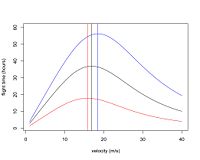Grouping behavior and the evolution of animal migration: Difference between revisions
From Santa Fe Institute Events Wiki
No edit summary |
No edit summary |
||
| Line 26: | Line 26: | ||
At this point we are independently reading papers and working with code to implement Ian's migration model. | At this point we are independently reading papers and working with code to implement Ian's migration model. | ||
==Background Info== | |||
[[Image:Power_curve.jpg|200px|thumb|left|alt text]] | |||
Revision as of 14:30, 13 June 2010
Meetings
Next meeting is scheduled for Sunday the 11th at 5:00pm in the coffee shop
Participants
Andrew Hein
Kyla Dahlin
Oana Carja
Ana Hocevar
Vanessa Weinberger
Leif Karlstrom
Project Summary
This project will start with some of the grouping behavior models that Ian Couzin showed us (see an example [[1]]). In addition to individuals evolving the ability to be 'informed' about the migratory route, I'd like to add another evolutionary trait: the ability to store fuel (e.g. fat). Increasing the amount of fuel stored is like increasing the amount of gas you put in your car. If you have some imperfect information about where you want to go, you are more likely to eventually get there without running out of gas if you start with more gas. In the case of migratory animals, increased fuel storage allows animals to search the landscape for a longer period of time. However, fuel storage comes at a great cost--individuals that store a lot of fuel experience drastically increased drag (fish, birds) and they must spend a lot of time gathering fuel before they migrate.
The goal of this project would be to let individuals evolve BOTH the ability to store information about the migratory route at a cost as in Ian's models, and the ability to store more fuel at a cost. We'd like to see what types of trait combinations evolve over a number of generations.
Questions:
(1) How does variation in fuel storage affect population viability?
(2) Is there a trade-off between time/distance taken to reach target and group knowledge?
Models
At this point we are independently reading papers and working with code to implement Ian's migration model.
Background Info

